
This three-act math task utilizes videos and questioning to help students explore multiplying a whole number by a fraction.
- Subject:
- Mathematics
- Material Type:
- Activity/Lab
- Provider:
- GFletchy
- Author:
- Graham Fletcher
- Date Added:
- 10/25/2022

This three-act math task utilizes videos and questioning to help students explore multiplying a whole number by a fraction.
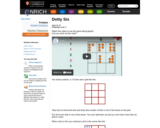
This dice game combines practice with basic number facts with strategic thinking. Students first are challenged to determine the rules of the game by watching a video of a game being played. The game is accompanied by a Teachers' Resource page that includes suggestions for approaching the problem, questions, extension ideas, and tips for support.
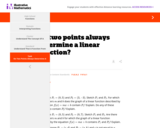
This problem allows the student to think geometrically about lines and then relate this geometry to linear functions. Or the student can work algebraically with equations in order to find the explicit equation of the line through two points (when that line is not vertical).
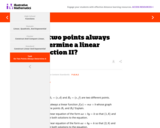
This task is designed as a follow-up to the task F-LE Do Two Points Always Determine a Linear Function? Linear equations and linear functions are closely related, and there advantages and disadvantages to viewing a given problem through each of these points of view. This task is not intended for assessment purposes: rather it is intended to show the depth of the standard F-LE.2 and its relationship to other important concepts of the middle school and high school curriculum, including ratio, algebra, and geometry.
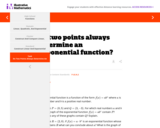
This task asks students to construct linear and exponential functions, including arithmetic and geometric sequences, given a graph, a description of a relationship, or two input-output pairs (include reading these from a table).
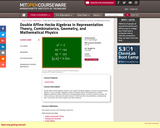
Double affine Hecke algebras (DAHA), also called Cherednik algebras, and their representations appear in many contexts: integrable systems (Calogero-Moser and Ruijsenaars models), algebraic geometry (Hilbert schemes), orthogonal polynomials, Lie theory, quantum groups, etc. In this course we will review the basic theory of DAHA and their representations, emphasizing their connections with other subjects and open problems.

Dr. Stephen O'Brien of the National Cancer Institute discovers a 700-year-old mutation that makes a person resistant to HIV infection. From Evolution: "Evolutionary Arms Race."
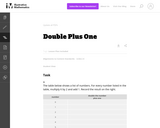
This task engages students in thinking about number patterns.

Based only on what we see when we watch stars in the sky, it’s easy to believe that the stars revolve around a stationary Earth, a common misconception among children. Although many students have at least heard that the Earth spins, they may not have thought about how this affects how we see stars, planets and the Moon.
In this activity, students find evidence of the Earth’s spinning through observing the apparent movement of stars. They use outstretched arms to measure the distance between a star and an object at the horizon. Later, they return to the same spot, re-measure, and notice that the star is in a different position, and try to explain this movement. Finally, the instructor shares the accepted scientific explanation for the phenomenon.

Explore tunneling splitting in double well potentials. This classic problem describes many physical systems, including covalent bonds, Josephson junctions, and two-state systems such as spin 1/2 particles and ammonia molecules.

This lesson is written using the Launch, Explore, Summarize lesson plan format and includes a link to a chart to anticipate student strategies and monitor student strategies and thinking as they work through the problems. Tasks also include a recording sheet where applicable. They are meant to be used as ideas. Please make changes and adaptations as necessary for the students in your class. All of the ideas for the tasks in this bank are common picture book math problems or were created by UVU School of Education Faculty. If you use one of these tasks, please complete our Picture Book Task Survey so that we can learn more about your experience teaching, how students solve problems, and improve our Picture Book Task Bank.If you have any questions, comments, or concerns, please feel free to contact us at creativelearning@uvu.edu or nicole.gearing@uvu.edu.

This problem requires students to have a good understanding of fractions and challenges children to visualize 3D shapes. Students are asked how to divide a doughnut into eight equal pieces using only three cuts. The Teachers' Notes page includes rationale, suggestions for implementation, discussion questions, and ideas for extension with a link to a worksheet and support.

This resource is a free, downloadable audio file of short music clips to use for instruction.

This resource is a free, downloadable audio file of short music clips to use for instruction.

This resource is a free, downloadable audio file of short music clips to use for instruction.
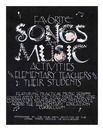
This resource includes the sheet music, activity instructions, and audio files for "Down by the Bay" from the Elementary Songbook.
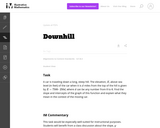
This task would be especially well-suited for instructional purposes. Students will benefit from a class discussion about the slope, y-intercept, x-intercept, and implications of the restricted domain for interpreting more precisely what the equation is modeling.

This resource is a free, downloadable audio file of short music clips to use for instruction.

This resource includes the sheet music, activity instructions, and audio files for "Down in the Valley" from the Elementary Songbook.

This three-act math task utilizes videos and questioning to help students explore addition and subtraction within 100.